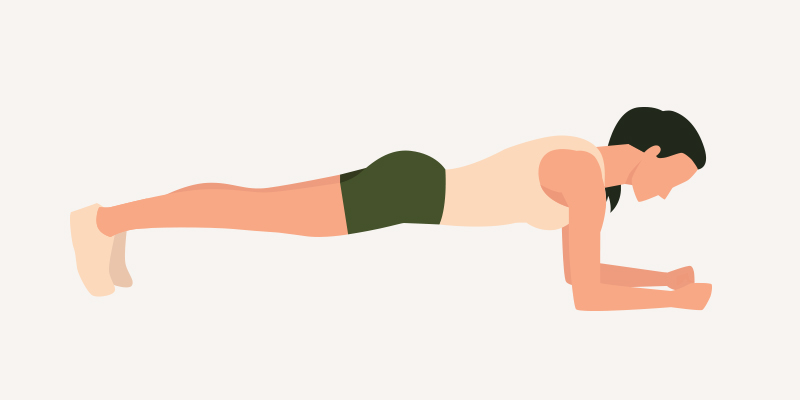- Main muscles worked: Core (including the rectus abdominus, obliques, erector spinae, and transverse abdominus), butt (glutes)
- Other muscles: Shoulders (deltoids), upper legs (quadriceps)
- Exercise type: Isometric
- Equipment: None
Planks. A staple of both yoga and Pilates and one of the best ab exercises you can do. But planks are so much more than an ab exercise. They’re an awesome move that will fire up your entire core (the muscles surrounding your spine and pelvis) and can reap major results.
But why stop there? Planks also hit all your major body parts, including your shoulders, arms, legs, and glutes. Some muscles can be targeted more than others, depending on the plank variation.
Benefits of Planks
Planks are an isometric exercise, which means that although your muscles are generating force, you do not create any movement. Many people focus on dynamic exercises that involve lots of movement, such as crunches, when doing core or abs workouts. And while this is totally fine, the core muscles tend to be more involved in preventing movement of the spine.
Picking up a heavy weight? Your core locks down and prevents your spine from rounding. Pushing or pulling a heavy load? Your core is the central link that passes the energy, effort, and force between your lower and upper body, allowing movement to ripple up or down through the body.
The core is essential in providing stability, enhancing balance, improving posture, and transferring force. In other words, your core plays a role in nearly every move you make and helps you perform exercises with proper form.12 So whether you’re into running, tennis, swimming, or just walking, a strong core is key.
The plank is one of the most functional (helps everyday activities) and foundational core exercises you can do, and a great way to level up your workout. Building a strong core helps to support and stabilize the spine during movement, which may reduce back pain and help prevent injury.34 Increasing core strength and stability may also improve athletic performance.5678 Planks are even used as a test of core strength.
There are lots of ways to do planks, but the standard plank is a forearm plank, which is also sometimes called a prone bridge or front bridge. The standard plank is a good place to start, as it features basic techniques that you need to master before moving onto more advanced plank variations.
Isometric exercises can cause your blood pressure to climb. This is not an issue for most people, but if you are hypertensive you’ll want to avoid elevating your blood pressure any further. For that reason, if you have been diagnosed with hypertension only perform planks with your doctor’s okay.9
Tips
Plank Form: The Detail
Follow the tips below to avoid making some common mistakes, nail the plank every time, and get the most from this highly effective exercise.
- Neck. Keep your chin tucked in and your neck long. Your neck should be in line with the rest of your body. Do not tilt your head up, as this strains the neck. Gaze down towards the floor to help keep your neck in a neutral position.
- Shoulders. Keep your shoulders down, not hunched up to your ears. Try to keep your neck, shoulders, and jaw relaxed.
- Abs. Engage your core – think of drawing your navel in to your spine.
- Hips. Do not lift or lower your hips – keep your body straight and level. Your shoulders, hips, knees and feet should form a straight line at all times. Tightening your abs, quads, and glutes helps to keep your body straight. Arching the back or hiking the hips up shifts the weight onto your arms, moves the work away from the core, and stresses the shoulders.
- Feet. Start with your feet about hip-width apart. Moving your feet closer together makes the exercise more challenging, while moving your feet further apart provides greater balance and stability making the plank easier.
- Breath. Breathe steadily throughout the exercise. It’s a common mistake to hold your breath during the exercise, which can elevate blood pressure.
How long should you hold a plank? Start with 5 seconds and gradually keep adding time until you can hold a plank for 30 seconds. Experts are divided on the optimal length of time to hold a plank. Some experts advocate 10-second planks, while others recommend holding planks for one minute, but generally not more than two minutes.10 You can perform multiple sets of planks.
To perform a plank you need to have sufficient core strength to keep your spine properly aligned to prevent injury. If full planks are too demanding right now don’t worry; start with the less demanding knee plank (also called three-quarter plank or tabletop plank).
More advanced plank variations will work your muscles in slightly different ways and keep your workouts interesting and challenging.


